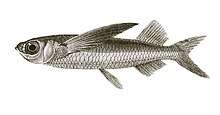Parexocoetus mento
Parexocoetus mento; also known as the African sailfin flying fish, Cuvier's flying fish, the yellow belly flying fish or the short-winged flying fish; is a species of flying fish from the family Exocoetidae which is found in the Indo-pacific region and which has colonised the eastern Mediterranean.
| Parexocoetus mento | |
|---|---|
 | |
| Scientific classification | |
| Kingdom: | Animalia |
| Phylum: | Chordata |
| Class: | Actinopterygii |
| Order: | Beloniformes |
| Family: | Exocoetidae |
| Genus: | Parexocoetus |
| Species: | P. mento |
| Binomial name | |
| Parexocoetus mento (Valenciennes, 1847) | |
| Synonyms[1] | |
| |
Description
Parexocoetus mento has an elongate body which is compressed and rounded ventrally. The lateral line has a pectoral branch. It has a protrusible upper jaw. The long pectoral fins reach the anal fin when folded but do not extend beyond it while the medium-sized pelvic fins do not extend far beyond the origin of the anal fin and are situated closer to it than they are to the pectoral fins. They are iridescent greenish-blue above and silvery below while the dorsal fin has a lot of black in it and the pectoral fins are greyish. It grows to a length of around to 10 centimetres (3.9 in).[2]
Distribution
Parexocoetus mento is found from the coast of East Africa and the Red Sea to Fiji, extending south to Queensland and the Mozambique Channel and north to southern Japan.[1] This species has colonised the Mediterraean Sea through the Suez Canal and by 1966 it had reached as far west as the Gulf of Sidra, it was one of the earliest and more widespread of the Lessepsian migrants.[3] Its Mediterranean distribution extends as far north as Albania and it is now common off Israel and Lebanon.[2]
Habitat and biology
Parexocoetus mento is found in coastal waters close to the surface and it is rarely recorded in open sea. These fishes can jump out of the water and glide over the water.[1] The eggs are covered in filaments and juveniles do not have any barbels.[2]
Taxonomy
Parexocoetus mento is the type species of the genus Parexocoetus which was erected by Pieter Bleeker in 1865,[4] this species was originally described as Exocoetus mento by Achille Valenciennes in 1847 with the type locality given as Puducherry, India.[5] Records of this species, as the subspecies atlanticus are erroneous.[1]
References
- Froese, Rainer and Pauly, Daniel, eds. (2019). "Parexocoetus mento" in FishBase. April 2019 version.
- J.C Hureau. "Fishes of the NE Atlantic and the Mediterranean". Marine Species Identification Forum. Marine Species Identification Portal. p. Parexocoetus mento. Retrieved 17 August 2019.
- Adam Ben Tuvia (1966). "Red Sea Fishes Recently Found in the Mediterranean". Copeia. 1966 (2): 254–275. doi:10.2307/1441133. JSTOR 1441133. Abstract
- Eschmeyer, W. N.; R. Fricke & R. van der Laan (eds.). "Parexocoetus". Catalog of Fishes. California Academy of Sciences. Retrieved 17 August 2019.
- Eschmeyer, W. N.; R. Fricke & R. van der Laan (eds.). "Parexocoetus mento". Catalog of Fishes. California Academy of Sciences. Retrieved 17 August 2019.